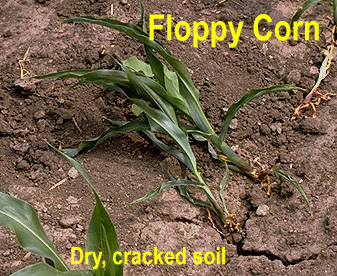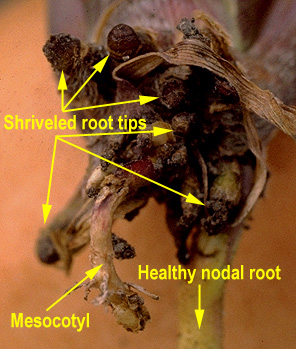![]() ainfall has not been in abundance throughout parts of
Indiana this spring, a fact substantiated by the exceptionally fast pace of
corn and soybean planting. Early corn and soybean planting are usually positive
for the development of yield potential. However, the significant drying of the
upper soil profile is also conducive for the development of what some of us
affectionately call the "floppy corn" syndrome.
ainfall has not been in abundance throughout parts of
Indiana this spring, a fact substantiated by the exceptionally fast pace of
corn and soybean planting. Early corn and soybean planting are usually positive
for the development of yield potential. However, the significant drying of the
upper soil profile is also conducive for the development of what some of us
affectionately call the "floppy corn" syndrome.
Nodal root elongation that begins in exceptionally dry soil or in soil cracks caused by rapidly drying clay soils may quickly cease growth if the roots do not encounter adequate soil moisture within a certain period of time. Without adequate soil moisture, the root tips can dessicate and die. If the soil remains dry long enough, the entire young root may die. It's possible for all the roots developing from a particular stalk node to die in this manner. At this point, the plant's survival depends on improved soil moisture conditions and the development of the next set of nodal roots (see my accompanying article, Corn Root Development for a brief background on 'normal' root development.)
 If dry soil
and/or hot, dry weather prevail, several sets of nodal roots may fail to form,
eventually giving rise to a "rootless corn" phenomenon. Affected plants somehow
depend on the seminal roots and mesocotyl for nourishment, when normally this
lifeline has already taken a backseat to the nodal root system.
If dry soil
and/or hot, dry weather prevail, several sets of nodal roots may fail to form,
eventually giving rise to a "rootless corn" phenomenon. Affected plants somehow
depend on the seminal roots and mesocotyl for nourishment, when normally this
lifeline has already taken a backseat to the nodal root system.
In addition to the nutrient stress imposed on the plants by a woefully inadequate nodal root system, the rootless phenomenon can eventually result in the floppy corn syndrome, whereby plants simply ‘flop’ over at the soil surface at the slightest nudge from wind, tire traffic or even crop scouts walking down the row.
These plants are NOT technically root-lodged, they are simply broken over at the base of the stem near the crown area. The nodal roots will appear stubbed off but not eaten. The root tips will be dry and shriveled.
 These symptoms are NOT like any associated with herbicide injury or
insect feeding. Because several sets of roots may not have formed below-ground,
the crown may "appear" to be at or above the surface.
These symptoms are NOT like any associated with herbicide injury or
insect feeding. Because several sets of roots may not have formed below-ground,
the crown may "appear" to be at or above the surface.
The important thing to remember is that roots do NOT grow toward moisture on purpose. If the root tips of very young roots die before soil moisture is encountered, elongation of those roots will simply cease. If roots are already in moist soil, however, they may proliferate rapidly enough to appear to "follow" moisture down as the soil dries.
What Can Be Done? Unfortunately, very little can be done to avoid the situation once it begins developing. Row cultivation may encourage root development if moist soil is thrown around the bases of the plants. However, if the soil is dry enough to be causing the problem in the first place, there's probably very little moist soil shallow enough to be brought up by row cultivation. The ultimate solution to the problem is a good soaking rain or at least enough of a rain to sustain new nodal root development long enough to allow the roots to reach deeper and hopefully wetter soil conditions before the upper soil dries again.
A Useful Reminder. ‘Rootless’ corn can also be caused from extremely shallow seeding depths that result in nodal root initiation beginning at the soil surface rather than at the usual ¾ inch depth. This is one of several reasons that growers should avoid choosing seeding depths shallower than about 1 to 1½ inches.
 For other
information about corn, take a look at the Corn Growers Guidebook on the World
Wide Web at http://www.kingcorn.org
For other
information about corn, take a look at the Corn Growers Guidebook on the World
Wide Web at http://www.kingcorn.org